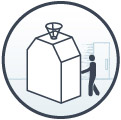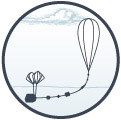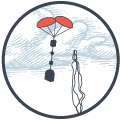Launching stratospheric balloons
The teams from the Canadian Space Agency (CSA) and France's space agency, the Centre national d'études spatiales (CNES), usually arrive at the launch site two weeks in advance to prepare the equipment that will be used during the campaign.
Once all of the setup is complete, the campaign begins. Each campaign lasts between six and eight weeks, depending on the number of balloons to be launched. On average, there are 10 balloon launches per campaign, and three to four days are anticipated for each operation. Balloon launches are always very dependent on weather conditions, which is why they normally take place early in the morning or later in the evening, when winds are at their lowest. During launch operation, the surface wind cannot exceed 2.5 to 4 metres per second, depending on the size of the balloon.
The final flight concludes the campaign. The two weeks that follow are used for storing equipment and post-campaign meetings.
Animation that shows what happens during a stratospheric balloon launch day. (Credit: CSA)
Launch day
-

Morning of the launch
Weather conditions are evaluated. If conditions are favourable, it continues; if not, conditions are reassessed later in the day or the release is postponed to the next day.
-

T−3 hours
The launch team take their positions. The final validation tests on the avionic gondola and the scientific gondola are finalized in the integration room. The auxiliary balloons used to hold the gondola during the release phase are filled with helium.
-

T−1 hour, 45 minutes
The avionic gondola is transported to the launch area. It is then integrated with the remaining elements of the flight chain for final testing and check-out.
-

T−1 hour, 30 minutes
The scientific gondola is transferred to the launch area: The gondola, which can weigh up to 1.1 tons, is assembled under the auxiliary balloons. Radio frequency link tests, between the gondola and the mission control centre, can take place during flight configuration activities.
-

T−1 hour
The main balloon is unfolded. The envelope is placed on a long protective mat. The operators, donning gloves, handle the balloon carefully as it is very fragile.
-

T−45 minutes
The balloon is inflated with helium by two operators. This can take 15 to 45 minutes.
-

T−0
Release. The main balloon is released and rises into the sky. Its ascent and flight path are monitored by the pilots in the control room using various instruments including the GPS and the transponders installed on the flight chain's gondolas. The balloon rises at a speed of approximately five metres per second. Once the balloon starts its ascent, the auxiliary balloons are separated from the gondola.
-

T+1 hour, 30 minutes
The balloon can climb to an altitude of up to 42 km. When it reaches the given ceiling for the flight, the collection of scientific data begins.
-

T+10 hours
The scientific mission ends. In the operations room, a suitable landing site is identified, in compliance with Safety and Mission Assurance rules. Air traffic control centres are notified and give clearance for the descending balloon to cross lower altitude airspace, used by commercial aviation, in a safe manner. The recovery team moves close to the landing site selected to secure the area. The order is given by the ground (remotely) to separate the flight chain and the envelope. Both sections (flight chain attached to a parachute and envelope in free fall) are monitored in real time until they reach the ground.
-

T+10 hours, 20 minutes
The envelope lands first after a free-fall descent at a speed of about 20 metres per second. The recovery team folds up the envelope to return it to the launch site.
-

T+10 hours, 45 minutes
The flight chain lands, typically within a 10-km radius of where the envelope landed. The recovery team secures the landing area of the flight chain. The electronic boxes are disconnected by ground crews who then request a helicopter to lift and carry heavy balloon components to a truck waiting on a road nearby.
-

T+14 hours
Repatriation: The truck is loaded with the balloon components and then returns them to the base.
